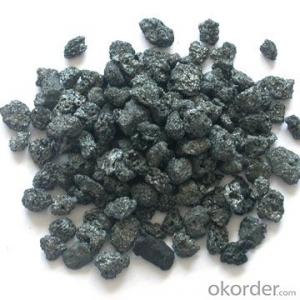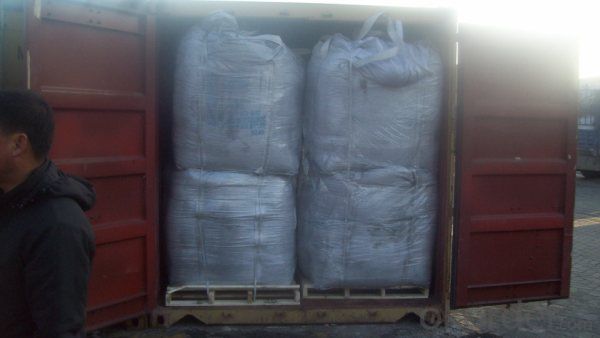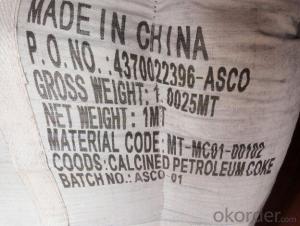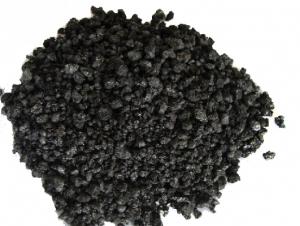Calcined Peroleum Coke with FC 98.5% S 0.7%
- Loading Port:
- Tianjin
- Payment Terms:
- TT OR LC
- Min Order Qty:
- 20 m.t.
- Supply Capability:
- 2000 m.t./month
OKorder Service Pledge
OKorder Financial Service
You Might Also Like
Packaging & Delivery
25kgs/50kgs/1ton per bag or as buyer's request
Calcined Petroleum Coke is a critical ingredient in the production of Metallurgy and chemical industrial ,it can increase the used quantity of Scrap steel and reduce the quantity of Scrap iron, or use no Scrap iron at all, the calcined petroleum coke has follow properties: high absorptive character, no residue will be left and save production cost.
User : Calcined Petroleum Coke comes from delayed coke which extracted from oil refinery. Although Calcined Petroleum Coke contains a little bit higher level of sulfur and nitrogen than pitch coke, the price advantage still makes it widely used during steel-making and founding as a kind of carbon additive/carburant.
General Specification of Calcined Anthracite:
| FC % | 98.5 | 98.5 | 98.5 | 99 |
| ASH % | 0.8 | 0.8 | 0.8 | 0.5 |
| V.M. % | 0.7 | 0.7 | 0.7 | 0.5 |
| S % | 0.5 | 0.55 | 0.7 | 0.5 |
| MOISTURE % | 0.5 | 0.5 | 0.5 | 0.5 |
Standard Sizes (Granulometry):
0-4 mm, 0.5-3 mm, 0-25 mm, 1-4 mm, 2-8 mm We also supply as per customer's requirement.
Picture of CPC/ Calcined Petroleum Coke
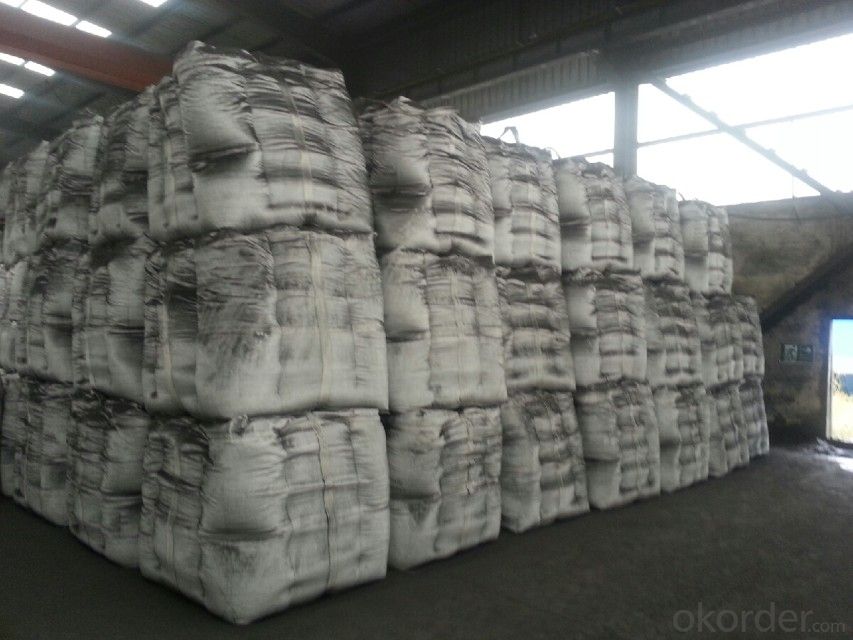
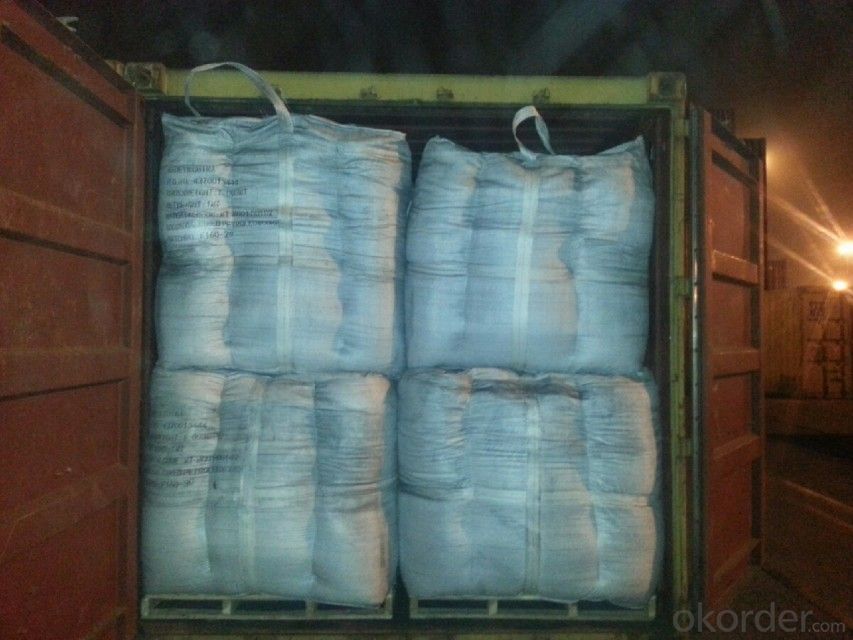
- Q: What's the reason for grading? What about the use of composites? What's the difference?
- 1, carbon fiber has a benzene ring structure, making it difficult to rotate the molecular chain. A polymer molecule cannot fold and stretch to form a rodlike structure, thus giving fibers a high modulus.The linear structure of carbon fiber polymers allows molecules to be arranged so closely that a large number of polymer molecules can be accommodated in a unit volume. This high density makes the fibers stronger.
- Q: What should be done to deal with leakage of carbon monoxide from the plant?
- The container should be cooled by heat in time. The harm to health, carbon monoxide and hemoglobin binding capacity than oxygen 200 times larger, after inhalation, in the blood and hemoglobin binding, interference blood carrying oxygen capacity, resulting in tissue hypoxia. The skin starts to become gray, and the skin and mucous membranes are red. Severe damage to brain cells can also cause secondary diseases, light damage to the heart, and damage to pyramidal or extrapyramidal systems, including the basal ganglia. Acute poisoning: mild poisoning are headache, dizziness, lethargy, tinnitus, palpitation, nausea, vomiting, weakness, abdominal pain, weakness and other symptoms; moderate poisoning in addition to the above symptoms, and complexion, lips cherry red, rapid pulse, irritability, instability of gait, fuzzy consciousness, coma patients remain unconscious;, miosis, muscle tension increased, frequent convulsions, incontinence, depth of poisoning due to respiratory paralysis and death. Chronic effects: the main manifestation of long-term inhalation of a certain amount of carbon monoxide, fatigue, irritability, indigestion and so on, can cause damage to the nervous and cardiovascular system. The compressed gas storage requirements in bottles, should be stored in a cool, ventilated warehouse, storage temperature should not exceed 300C; keep away from heat, avoid direct sunlight; and oxygen, compressed air, oxidant and stored separately; avoid mixed mixed transport. The lighting, ventilation and other facilities in the storage room shall be explosion-proof, and the switch is located outside the warehouse. Equipped with appropriate varieties and corresponding quantity of fire-fighting equipment.
- Q: How are carbon nanotubes used in various applications?
- Carbon nanotubes are used in various applications due to their unique properties. They are used in electronics and semiconductors for their high conductivity, in energy storage devices for their high surface area and lightweight nature, and in medicine for drug delivery and imaging purposes. Additionally, carbon nanotubes find applications in materials science, aerospace engineering, and environmental remediation, among others, showcasing their versatility and potential impact across multiple fields.
- Q: What are the effects of carbon emissions on the stability of wetlands?
- The stability of wetlands is significantly impacted by carbon emissions. One of the main consequences is the disruption of the hydrological cycle, which can disturb the delicate balance of water levels in wetland ecosystems. The increased release of carbon emissions contributes to climate change and global warming, resulting in higher temperatures and changed patterns of precipitation. These alterations can lead to more frequent and severe droughts, floods, and storms, negatively affecting the stability of wetlands. Moreover, elevated levels of carbon dioxide also influence the vegetation in wetlands. Excess carbon dioxide can stimulate the growth of specific plant species, causing an imbalance in the wetland ecosystem. This imbalance can lead to the dominance of invasive species, which outcompete native plants and disrupt the natural biodiversity of the wetland. Consequently, the stability of the wetland is impacted as it relies on a diverse range of plant species to support the intricate web of life within it. Additionally, carbon emissions contribute to the acidification of water bodies, including wetlands. Increased carbon dioxide dissolves in water, forming carbonic acid, which lowers the pH of the water. Acidic conditions can be harmful to the survival of many wetland species, including plants, amphibians, fish, and invertebrates. The acidification of water can also result in the release of toxic metals and other pollutants from surrounding soils, further compromising the stability and health of wetland ecosystems. Lastly, carbon emissions contribute to the rise of sea levels due to the melting of polar ice caps and expansion of ocean waters. This poses a significant threat to coastal wetlands, which are particularly vulnerable to sea-level rise. As sea levels increase, there is a risk of saltwater intrusion, leading to the degradation and loss of freshwater wetlands. This loss can cause the displacement or extinction of numerous plant and animal species that depend on these ecosystems, ultimately destabilizing the wetland. In conclusion, the stability of wetlands is profoundly impacted by carbon emissions. From the disruption of the hydrological cycle and alteration of vegetation composition to the acidification of water and sea-level rise, these emissions pose a significant threat to the health and integrity of wetland ecosystems. It is essential to reduce carbon emissions and implement measures to protect and restore wetlands to ensure their stability and preserve the invaluable services they provide.
- Q: Does iron have more carbon or more steel?
- Iron has a high carbon contentThe main difference is that the pig iron, wrought iron and steel carbon content, carbon content of more than 2% of iron is iron; carbon content of less than 0.04% of the iron, the carbon content in the name of wrought iron; 0.05~2% iron, known as steel.
- Q: What are the consequences of increased carbon emissions on tourism industry?
- Increased carbon emissions have significant consequences on the tourism industry. One of the most prominent effects is the deterioration of natural landscapes and ecosystems that attract tourists. Carbon emissions contribute to global warming, resulting in rising temperatures, melting glaciers, and increased instances of extreme weather events like hurricanes and droughts. These environmental changes can lead to the destruction of iconic landmarks, such as coral reefs or national parks, which are often the main attractions for tourists. Furthermore, increased carbon emissions contribute to air pollution, which can negatively impact air quality in popular tourist destinations. Poor air quality can lead to respiratory issues and other health problems for both tourists and local populations, making these places less desirable to visit. Additionally, the degradation of natural environments due to carbon emissions can also affect wildlife, leading to a decline in biodiversity. This loss of wildlife can reduce the appeal of ecotourism destinations, which heavily rely on the presence of diverse flora and fauna. Moreover, the tourism industry heavily relies on transportation, which is a significant source of carbon emissions. The use of fossil fuels in planes, ships, and cars contributes to the overall carbon footprint of the industry. As countries strive to reduce their carbon emissions, they may impose stricter regulations or taxes on air travel, making it more expensive and less accessible for travelers. This can impact the number of tourists visiting different destinations and hinder the growth of the tourism industry. Lastly, the consequences of increased carbon emissions extend beyond environmental factors. Climate change and extreme weather events can disrupt travel plans, leading to cancellations and financial losses for both tourists and businesses in the tourism industry. Moreover, destinations that heavily rely on winter tourism, such as ski resorts, may face challenges due to shorter snow seasons or inconsistent snowfall patterns caused by climate change. In conclusion, increased carbon emissions have severe consequences on the tourism industry. From the degradation of natural landscapes and ecosystems to the impact on air quality and wildlife, the effects of carbon emissions can deter tourists from visiting certain destinations. Additionally, the reliance of the tourism industry on transportation contributes to its overall carbon footprint, potentially leading to increased costs and reduced accessibility for travelers. Climate change-related disruptions and financial losses further compound the challenges faced by the tourism industry.
- Q: What's the difference between an alkaline cell and a carbon cell?
- Alkaline batteries, also known as alkaline dry cells, alkaline manganese dioxide batteries and alkaline manganese batteries, are among the best in the range of zinc manganese batteries. The utility model is suitable for large discharge capacity and long time use. The internal resistance of the battery is low, so the current produced is larger than that of the general manganese battery, while the environmental friendly mercury content is only 0.025%. A carbon cell belongs to a primary battery in a chemical power supply and is a disposable battery. Because the chemical power unit has an electrolyte that is a non flowing paste, it is also called a dry cell, as opposed to a battery with a flowing electrolyte. Carbon battery is not only suitable for the flashlight, radios, tape recorders, cameras, semiconductor, electronic clocks, toys and other fields, but also for national defense, scientific research, telecommunication, navigation, aviation, medicine, etc. in the national economy.
- Q: How does carbon impact the productivity of marine ecosystems?
- Carbon impacts the productivity of marine ecosystems in several ways. One of the main ways is through ocean acidification. When carbon dioxide from human activities is released into the atmosphere, a significant portion of it gets absorbed by the oceans. This excess carbon dioxide reacts with seawater to form carbonic acid, leading to a decrease in the pH of the ocean. This increase in acidity has detrimental effects on many marine organisms, especially those that rely on calcium carbonate to build their shells or skeletons, such as corals, shellfish, and some plankton species. Ocean acidification inhibits the process of calcification, making it difficult for these organisms to develop and maintain their protective structures. This not only affects their survival but also impacts the entire food chain. Many species rely on these calcium carbonate structures as a food source or for shelter, so a decline in their productivity can have cascading effects on the ecosystem. Additionally, increased carbon dioxide levels in the ocean can also affect the metabolism and physiology of marine organisms. Some studies have found that elevated CO2 concentrations can impair the growth, development, and reproductive success of certain species. This can lead to a decrease in overall productivity within the ecosystem. Furthermore, climate change, driven by the accumulation of carbon dioxide in the atmosphere, also impacts marine ecosystems. Rising temperatures can disrupt the delicate balance of marine ecosystems, affecting the distribution and abundance of species, altering predator-prey relationships, and leading to changes in the timing of vital ecological events such as spawning or migration. These changes can have profound impacts on the productivity of marine ecosystems, as different species may struggle to adapt or compete under new conditions. In conclusion, carbon dioxide emissions have far-reaching consequences for marine ecosystems. Ocean acidification and climate change, driven by excessive carbon dioxide, have detrimental effects on the productivity of marine ecosystems, affecting the growth, survival, and reproductive success of marine organisms. The impacts of carbon on marine ecosystems highlight the urgent need to reduce greenhouse gas emissions and mitigate the effects of climate change to protect these fragile and vital ecosystems.
- Q: What is a carbon electrode? What's the use? What's the current situation in the industry? Try to be specific. Thank you
- Tons of ferrosilicon smelting costs reduced by 300-400 yuan, tons of calcium carbide smelting costs reduced by more than 100 yuan.Carbon electrode is an energy saving and environmental friendly product. It can greatly reduce power consumption and reduce pollution in the use of calcium carbide and ferroalloy ore heating furnaces. It is the replacement product of electrode paste. In the submerged arc furnace with the same capacity, electrode paste self baking electrode compared with the following characteristics: improving smelting furnace production, reduce power consumption and reduce the labor intensity (15-20%; 1 tons of iron smelting alloy consumption of electrode paste carbon electrode about 60kg, consumption is only about 12kg, reduce the operating times of the electrode), simplified production process; to avoid or reduce the self baking electrode frequent "broken soft" and "hard" accidents, improve the working environment, reduce operating costs.
- Q: What is the difference between carbon nanomaterials and nano carbon materials?
- Carbon nanomaterials are a general term for carbon nanotubes, carbon nanofibers, and so on. Therefore, there are differences and connections between these two statements.
Send your message to us
Calcined Peroleum Coke with FC 98.5% S 0.7%
- Loading Port:
- Tianjin
- Payment Terms:
- TT OR LC
- Min Order Qty:
- 20 m.t.
- Supply Capability:
- 2000 m.t./month
OKorder Service Pledge
OKorder Financial Service
Similar products
Hot products
Hot Searches
